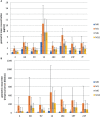Single-Dose 13-Valent Conjugate Pneumococcal Vaccine in People Living With HIV - Immunological Response and Protection
- PMID: 34987514
- PMCID: PMC8721113
- DOI: 10.3389/fimmu.2021.791147
Single-Dose 13-Valent Conjugate Pneumococcal Vaccine in People Living With HIV - Immunological Response and Protection
Abstract
Background: Patients living with HIV (PLHIV) are prone to invasive pneumococcal disease. The 13-valent conjugated pneumococcal vaccine (PCV13) is currently recommended for all PLHIV, followed in most guidelines by a 23-valent polysaccharide pneumococcal vaccine. Data are scarce concerning the immunological efficacy of PCV13 among PLHIV.
Objective: To assess the immunological response at one month, and the immunological protection at 1-, 6-, and 12 months in PLHIV with a CD4 cell count above 200 cells/µl after a single dose of PCV13, as measured by both ELISA and opsonophagocytic assay (OPA).
Methods: PLHIV with CD4 cell count >200 cells/µl were included. Specific IgG serum concentrations for eight serotypes by ELISA and seven serotypes by OPA were measured at baseline, 1-, 6-, and 12 months after the PCV13 vaccination. Global response was defined as a two-fold increase from baseline of specific IgG antibody levels (μg/ml) assayed by ELISA or as a four-fold increase in OPA titer from baseline, for at least five serotypes targeted by PCV13. Global protection was defined as an IgG-concentration ≥1 µg/ml by ELISA or as an opsonization titer ≥LLOQ by OPA for at least five tested serotypes targeted by PCV13. Factors associated with global response and global protection were assessed using logistic regression.
Results: Of the 38 PLHIV included, 57.9% and 63.2% were global responders, 92.1% and 78.9% were globally protected at one month, and 64.7% and 55.9% were still protected at 12 months, by ELISA and OPA respectively. A CD4/CD8 ratio of >0.8 was significantly associated with a better global response by OPA (OR=6.11, p=0.02), and a CD4 nadir <200 was significantly associated with a poorer global response by ELISA (OR=0.22, p=0.04). A CD4 cell count nadir <200 and age over 50 years were associated with poorer global protection by OPA at M1 (OR=0.18, p=0.04) and M12 (OR= 0.15, p=0.02), respectively. Plasma HIV RNA viral load <40 copies/ml was significantly associated with a better global protection at M1 by ELISA and OPA (OR=21.33, p=0.025 and OR=8.40, p=0.04).
Conclusion: Vaccination with PCV13 in these patients induced immunological response and protection at one month. At one year, more than half of patients were still immunologically protected.
Keywords: France; HIV infection; cohort study; immunogenicity; immunological protection; immunological response; pneumococcal conjugate vaccine (PCV).
Copyright © 2021 Romaru, Bahuaud, Lejeune, Hentzien, Berger, Robbins, Lebrun, N’Guyen, Bani-Sadr, Batteux and Servettaz.
Conflict of interest statement
The authors declare that the research was conducted in the absence of any commercial or financial relationships that could be construed as a potential conflict of interest.
Figures

Similar articles
-
Immunogenicity and safety of the 13-valent pneumococcal conjugate vaccine in HIV-infected individuals naive to pneumococcal vaccination.AIDS. 2015 Jul 17;29(11):1345-54. doi: 10.1097/QAD.0000000000000689. AIDS. 2015. PMID: 25888646 Free PMC article. Clinical Trial.
-
Pneumococcal conjugate vaccine triggers a better immune response than pneumococcal polysaccharide vaccine in patients with chronic lymphocytic leukemia A randomized study by the Swedish CLL group.Vaccine. 2018 Jun 14;36(25):3701-3707. doi: 10.1016/j.vaccine.2018.05.012. Epub 2018 May 7. Vaccine. 2018. PMID: 29748028
-
Pneumococcal conjugate vaccine-elicited antibody persistence and immunogenicity and safety of 13-valent pneumococcal conjugate vaccine in children previously vaccinated with 4 doses of either 7-valent or 13-valent pneumococcal conjugate vaccine.Pediatr Infect Dis J. 2014 Oct;33(10):1065-76. doi: 10.1097/INF.0000000000000459. Pediatr Infect Dis J. 2014. PMID: 25093973 Clinical Trial.
-
Pneumococcal vaccination among HIV-infected adult patients in the era of combination antiretroviral therapy.Hum Vaccin Immunother. 2014;10(12):3700-10. doi: 10.4161/hv.32247. Hum Vaccin Immunother. 2014. PMID: 25483681 Free PMC article. Review.
-
Immunogenicity and safety of the 13-valent pneumococcal conjugate vaccine compared to 23-valent pneumococcal polysaccharide in immunocompetent adults: A systematic review and meta-analysis.Vaccine. 2019 Feb 14;37(8):1021-1029. doi: 10.1016/j.vaccine.2019.01.014. Epub 2019 Jan 23. Vaccine. 2019. PMID: 30685252
Cited by
-
Pneumococcal vaccine hyporesponsiveness in people living with HIV: A narrative review of immunological mechanisms and insights from minimally invasive lymph node sampling.Hum Vaccin Immunother. 2025 Dec;21(1):2503602. doi: 10.1080/21645515.2025.2503602. Epub 2025 May 15. Hum Vaccin Immunother. 2025. PMID: 40374620 Free PMC article. Review.
-
The Current Status in Terms of Vaccination for Individuals Infected with Human Immunodeficiency Virus.Viruses. 2025 Jan 25;17(2):171. doi: 10.3390/v17020171. Viruses. 2025. PMID: 40006926 Free PMC article. Review.
-
Immunological and Clinical Responses to Vaccinations among Adults Living with HIV.Life (Basel). 2024 Apr 24;14(5):540. doi: 10.3390/life14050540. Life (Basel). 2024. PMID: 38792562 Free PMC article. Review.
References
-
- Heffernan RT, Barrett NL, Gallagher KM, Hadler JL, Harrison LH, Reingold AL, et al. . Declining Incidence of Invasive Streptococcus Pneumoniae Infections Among Persons With AIDS in an Era of Highly Active Antiretroviral Therapy, 1995—2000. J Infect Dis (2005) 191:2038–45. doi: 10.1086/430356 - DOI - PubMed
-
- Song JY, Cheong HJ, Noh JY, Choi MJ, Yoon JG, Kim WJ. Immunogenicity and Safety of 13-Valent Pneumococcal Conjugate Vaccine in HIV-Infected Adults in the Era of Highly Active Antiretroviral Therapy: Analysis Stratified by CD4 T-Cell Count. Hum Vaccines Immunotherapeutics (2020) 16:169–75. doi: 10.1080/21645515.2019.1643677 - DOI - PMC - PubMed
MeSH terms
Substances
LinkOut - more resources
Full Text Sources
Medical
Research Materials

